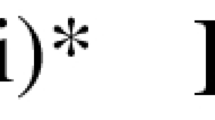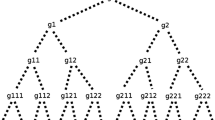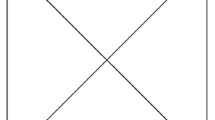Abstract
Many of those who accept the universalist thesis that mereological composition is unrestricted also maintain that the folk typically restrict their quantifiers in such a way as to exclude strange fusions when they say things that appear to conflict with universalism. Despite its prima facie implausibility, there are powerful arguments for universalism. By contrast, there is remarkably little evidence for the thesis that strange fusions are excluded from the ordinary domain of quantification. Furthermore, this reconciliatory strategy seems hopeless when applied to the more fundamental conflict between universalism and the intuitions that tell against it.
Similar content being viewed by others
Notes
More cautiously, universalists are committed either to the existence of this fusion or to the nonexistence of one or the other of my nose and the Eiffel Tower (which would be no less surprising).
Although explicit endorsements of this view in the literature are rare—and defenses of it rarer still—the view is widespread and is commonly cited as the standard universalist account of the apparent conflict with folk belief: see Lewis (1986, 213), Sosa (1999, 142), Sider (2001, 137 and 218; 2004, 680), Hirsch (2002, 111–2), Rosen and Dorr (2002, 155–7), Varzi (2003, 213–4), López de Sa (2006, 399), and Markosian (forthcoming, §3).
Cf. Merricks (2001, 162–85), who attempts to account for the apparent conflict between eliminativism and folk belief without denying that the conflict is genuine.
One might wonder what reason there would be for someone who does not accept universalism to embrace restrictivism, but this only speaks to the main point of the paper, namely, that restrictivism lacks independent motivation.
See Stanley and Szabó (2000) for discussion of the various approaches to quantifier domain restriction.
Restrictivists presumably will not say that the folk believe that there are no strange fusions, for this is to admit that there is a genuine conflict between universalism and folk belief, which is at least as bad as (and presumably worse than) a conflict with what the folk say. And the view that the folk positively do (already) believe in such strange fusions as the thing composed of my nose and the Eiffel Tower is wholly implausible.
Likewise, one who says ‘there is only one white thing on the table’ knows full well that the feather has parts that are white, and will take himself to be the victim of a deliberate misunderstanding if one reminds him that he neglected to count those parts.
There is even some amount of linguistic evidence supporting the Lewisian hypothesis that we typically restrict our quantifiers to exclude nonpresent and nonactual entities. For at times we seem willing to quantify over such entities, as in ‘There are many people who have died for their cause’ and ‘There are many things that we feared as children that we no longer believe in’. Of course, there is more than one way of understanding such utterances. But the point is just that not there is not even this minimal evidence for restrictivism and that not all seemingly revisionary postulations of tacit domain restrictions are as unmotivated as restrictivism.
Nor, I should add, is their willingness to agree that there are strange fusions always an indication that they have been convinced of anything; it is often far more plausible that they are simply playing along in the spirit of cooperation (and because they do not know how else to respond to such an outlandish suggestion). Cf. Bonomi (2006) on “discommodation.”
See van Inwagen (1990, 98–114).
See Rosen and Dorr (2002, 168–71).
Varzi (2002, 65).
If the magnetic theory is to be at all plausible, there must be some restriction on the range of utterances whose verification counts in favor of an interpretation; that an interpretation verifies the pre-Copernican utterances of ‘the sun goes around the earth’ should not even be a pro tanto reason for favoring that interpretation. So the envisaged restrictivist would have to assume, further, that the utterances that he wishes to reconstrue (e.g., ‘nothing on the table is partly white and partly black’, ‘the feather is not part of anything on the table’) are in this privileged class of utterances that need to be verified by a use-respecting interpretation. I will simply grant that they are; to evaluate whether they indeed belong to this privileged class would require an investigation into the foundations of this kind of magnetic theory that would take us far beyond the scope of this article.
Both commonsense ontologists and their critics will agree that there is almost certainly no uniform or elegant way to capture the conditions under which the folk (ostensibly) take some things to compose something. See, e.g., van Inwagen (1990), Hirsch (1993), Horgan (1993), Markosian (1998), and Johnston (2002, 147).
See Stanley (2001, 47) for a related point concerning fictionalist strategies for reconciling ordinary discourse with revisionary metaphysical theses.
Contra Sider (2007, 62), it is on the basis of such intuitions—and not the fact that such objects are “undreamt of by most”—that many philosophers resist universalism. Nor can their being undreamt of plausibly explain our intuitions, for we are ordinarily willing to countenance the possibility of all manner of undreamt of things (evil demons, inverts, twin earths, etc.)
Weatherson is an exception (see his 2003). But his argument presupposes a magnetic theory of content which, as we have seen, fails to render any clear verdict regarding restrictivist interpretations of discourse about material objects.
Kripke (1980, 103–5).
Cf. Sider (2001, 183) on anti-eliminativist intuitions.
Accordingly, let us suspend our assumption that universalism is correct.
See, e.g., Dorr (2005), Chalmers (forthcoming), and Sider (forthcoming) for discussion of the language of the ontology room. N.B. Some who invoke the language of the ontology room take themselves to be speaking strict and literal English. But it is only by invoking the ontology room in the more radical way just described that one is in a position to make the indicated concessions and thereby bypass the threat of counterexamples.
Cf. Sider (2001, 121–132).
Or perhaps it would then mean the same as the Nihilese quantifier, in which case the Ontologese premise ‘If composition is not unrestricted, then there are borderline cases of composition’ would be false.
Similar remarks apply to the suggestion that the truth of ‘composition is unrestricted’ in Ontologese can be established by appeal to its featuring in the best comprehensive theory. The idea would be that the best systematization of our judgments about which Ontologese sentences are true and which are false includes or entails the Ontologese sentence ‘composition is unrestricted’. But we are in no position to judge which Ontologese sentences are true until we know what they mean. And we cannot know what they mean until we know whether there can be quantifiers that are more comprehensive than the English quantifier which, in turn, is what we are in the middle of trying to establish. So we are in no position to assess this argument. In fact, our only clue as to the form of the best comprehensive theory in Ontologese is that the best systematization of the sound-alike English sentences does not include or entail the English sentence ‘composition is unrestricted’ (since, as we are presently supposing, universalism is false).
See Rosen and Dorr (2002, 168–71).
Hawthorne and Michael (1996, 118).
References
Bonomi, A. (2006). Truth and reference in context. The Journal of Semantics, 23, 107–134.
Cartwright, R. (1975). Scattered objects. In K. Lehrer (Ed.), Analysis and metaphysics (pp. 153–171). Boston: Reidel Publishing Company.
Chalmers, D. (forthcoming). Ontological Anti-Realism. In D. Chalmers, D. Manley, & R. Wasserman (Eds.), Metametaphysics. Oxford: Oxford University Press.
Chisholm, R. M. (1976). Person and object. London: George Allen and Unwin Ltd.
Dorr, C. (2005). What we disagree about when we disagree about ontology. In M. Kalderon (Ed.), Fictionalism in metaphysics (pp. 234–286). Oxford: Clarendon Press.
Grandy, R. (1973). Reference, meaning, and belief. The Journal of Philosophy, 70, 439–452.
Hawthorne, J., & Michael, M. (1996). Compatibilist semantics in metaphysics: A case study. Australasian Journal of Philosophy, 74, 117–134.
Heller, M. (1990). The ontology of physical objects: Four-dimensional hunks of matter. New York: Cambridge University Press.
Hirsch, E. (1993). Peter van Inwagen’s Material beings. Philosophy and Phenomenological Research, 53, 687–691.
Hirsch, E. (2002). Against revisionary ontology. Philosophical Topics, 30, 103–127.
Horgan, T. (1993). On what there isn’t. Philosophy and Phenomenological Research, 53, 693–700.
Hudson, H. (2001). A materialist metaphysics of the human person. Ithica: Cornell University Press.
Johnston, M. (2002). Parts and principles: False axioms in mereology. Philosophical Topics, 30, 129–166.
Kripke, S. (1980). Naming and necessity. Cambridge: Harvard.
Kripke, S. (1982). Wittgenstein on rules and private language. Cambridge: Harvard.
Lewis, D. (1974). Radical interpretation. Synthese, 23, 331–344.
Lewis, D. (1983). New work for a theory of universals. Australasian Journal of Philosophy, 61, 343–377.
Lewis, D. (1984). Putnam’s paradox. Australasian Journal of Philosophy, 62, 221–236.
Lewis, D. (1986). On the plurality of worlds. Malden: Blackwell.
López de Sa, D. (2006). Is “everything” precise?. Dialectica, 60, 397–409.
Markosian, N. (1998). Brutal composition. Philosophical Studies, 92, 211–249.
Markosian, N. (forthcoming). Restricted composition. In J. Hawthorne, T. Sider, & D. Zimmerman (Eds.), Contemporary debates in metaphysics. Basil Blackwell.
Merricks, T. (2001). Objects and persons. New York: Oxford University Press.
Quine, W. V. O. (1960). Word and object. Cambridge: MIT Press.
Quine, W. V. O. (1981). Theories and things. Cambridge: Harvard University Press.
Rea, M. C. (1998). In defense of mereological universalism. Philosophy and Phenomenological Research, 58, 347–360.
Rosen, G., & Dorr, C. (2002). Composition as fiction. In R. M. Gale (Ed.), The Blackwell guide to metaphysics (pp. 151–174). Oxford: Blackwell.
Sider, T. (2001). Four-dimensionalism. Oxford: Clarendon Press.
Sider, T. (2004). Replies to Gallois, Hirsch and Markosian. Philosophy and Phenomenological Research, 58, 674–687.
Sider, T. (2007). Parthood. The Philosophical Review, 116, 51–91.
Sider, T. (forthcoming). Ontological realism. In D. Chalmers, D. Manley, & R. Wasserman (Eds.), Metametaphysics. Oxford: Oxford University Press.
Sosa, E. (1999). Existential relativity. Midwest Studies in Philosophy, 23, 132–143.
Stanley, J. (2001). Hermeneutic fictionalism. Midwest Studies in Philosophy, 25, 36–71.
Stanley, J., & Szabó, Z. (2000). On quantifier domain restriction. Mind and Language, 15, 219–261.
van Cleve, J. (1986). Mereological essentialism, mereological conjunctivism, and identity through time. Midwest Studies in Philosophy, 11, 141–156.
van Inwagen, P. (1990). Material beings. Ithica: Cornell.
Varzi, A. C. (2002). Words and objects. In A. Bottani, M. Carrara, & D. Giaretta (Eds.), Individuals, essence, and identity: Themes of analytic metaphysics (pp. 49–75). Dordrecht, Boston, and London: Kluwer Academic Publishers.
Varzi, A. C. (2003). Perdurantism, universalism, and quantifiers. Australasian Journal of Philosophy, 81, 208–215.
Varzi, A. C. (2005). Change, temporal parts, and the argument from vagueness. Dialectica, 59, 485–498.
Weatherson, B. (2003). What good are counterexamples?. Philosophical Studies, 115, 1–31.
Wiggins, D. (1980). What would be a substantial theory of truth?. In Z. van Straaten (Ed.), Philosophical subjects: Essays presented to P. F. Strawson (pp. 189–221). Oxford: Clarendon Press.
Acknowledgements
I am grateful to John Bengson, Chad Carmichael, Matti Eklund, Eli Hirsch, Dave Liebesman, Mark Sainsbury, Adam Sennet, David Sosa, Ted Sider, and Jason Turner for helpful discussion.
Author information
Authors and Affiliations
Corresponding author
Rights and permissions
About this article
Cite this article
Korman, D.Z. Unrestricted composition and restricted quantification. Philos Stud 140, 319–334 (2008). https://doi.org/10.1007/s11098-007-9147-3
Received:
Accepted:
Published:
Issue Date:
DOI: https://doi.org/10.1007/s11098-007-9147-3




